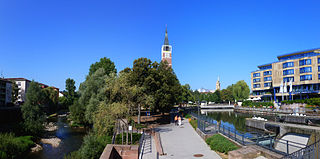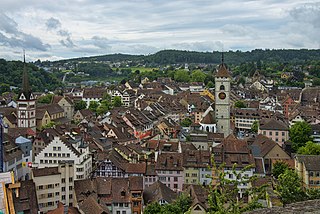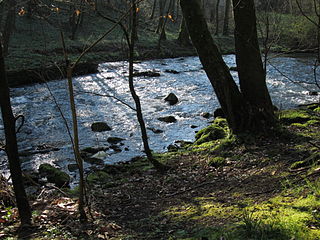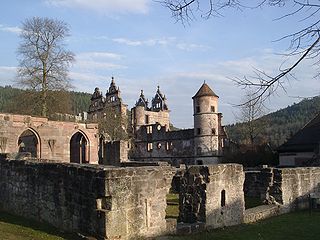
Hunter Mountain is in the towns of Hunter and Lexington, just south of the village of Hunter, in Greene County, New York, United States. At approximately 4,040 feet (1,231 m) in elevation, it is the highest peak in the county and the second-highest peak in the Catskill Mountains.
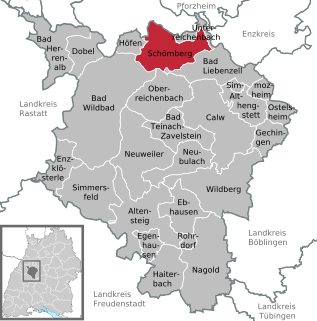
Schömberg is a spa town in the north of the Black Forest in Baden-Württemberg.
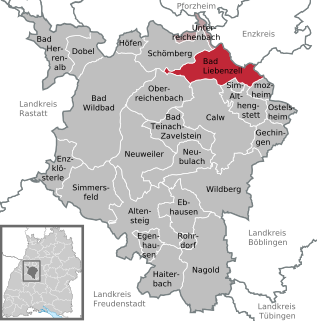
Bad Liebenzell is a spa town in the Nagold River valley, the northern part of the Black Forest. It was first mentioned in 1090 and is the heart of the Liebenzeller Mission.

The Kinzig is a river in southwestern Germany, a right tributary of the Rhine.

The E1 European long-distance path, or just E1 path, is one of the European long-distance paths designated by the European Ramblers' Association. It has a total length of some 4,960 miles (7,980 km). It begins in Norway at Nordkapp, and crosses the Kattegat between Sweden and Denmark by ferry. It passes through Denmark, Germany, and Switzerland to finish at Scapoli, Italy. This path was extended southwards to Sicily, in Italy in 2018.
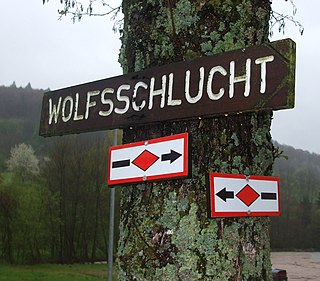
The Westweg is a long-distance hiking trail in Germany, running north-south through the Black Forest from Pforzheim to Basel. The trail is around 285 km long, and was founded in 1900. It is currently maintained under the auspices of the Black Forest Club. The trail symbol is a red lozenge on a white background. The Westweg is a part of the European Long-distance Trail E1 The route passes through or near numerous villages or small towns, so there is no difficulty in finding overnight accommodation and meals along the route. It would actually require more planning to walk it while staying in youth hostel-type accommodation, or camping. There are a number of services that will transport your luggage to the next accommodation by vehicle, leaving the hikers with only their daypacks for the hike. The route can be accessed at several places along its length by road or public transport, so it is easy to walk part of it or to do day walks along its route.

The Nagold Valley Railway is a railway line in the northern part of the Black Forest in Germany which links Pforzheim with Horb am Neckar and, for most of its route, follows the valley of the River Nagold.

The Bertha Benz Memorial Route is a German tourist and theme route in Baden-Württemberg and member of the European Route of Industrial Heritage. It opened in 2008 and follows the tracks of the world's first long distance road trip by a vehicle powered with an internal combustion engine, in 1888.

The Kniebis is a 960-metre-high mountain ridge in the Black Forest and the name of a village to the south which is a dispersed settlement. The Kniebis mountain rises in the state of Baden-Württemberg, Germany.

The Eutingen im Gäu–Freudenstadt railway is a railway line in the German state of Baden-Württemberg that runs from the cultural landscape of the Gäu to the eastern edge of the Black Forest, connecting Eutingen and Freudenstadt. It is a section of the Gäu Railway from Stuttgart to Freudenstadt opened on 1 September 1879.

The Nagold is a river, 91 kilometres long, in Baden-Württemberg, southwestern Germany. A tributary of the Enz, it gave its name to the town of Nagold. It merges with the smaller Enz in the town centre of Pforzheim.

The East Highland Way is a long distance walking route in Scotland that connects Fort William (56.8178°N 5.1109°W) with the ski and mountain resort of Aviemore (57.1899°N 3.8292°W). The route was described by the architect Kevin Langan in 2007. The name is derived from the fact that the route terminates in Aviemore at the eastern edge of Highland region. The EHW route takes in a varied and wild landscape through deep forest plantations, passing many highland lochs and negotiating unspoilt marshlands. The route also explores the ancient Caledonian forests of Inshriach. The walk is 82 miles (132 km) long.

Walking routes in the Palatine Forest fall into two categories. The first are longer walking routes, most of which are maintained by the Palatine Forest Club, or PWV, and which are linked to the national and international network of long distance paths. The second category are those local circular walks and themed walking routes, some of which are of wider regional importance, and which are maintained by municipal authorities. The Palatine Forest, as part of the Palatine Forest-North Vosges Biosphere Reserve, is an important conservation area. As a result, the Palatine Forest, the bunter sandstone landscape of the Palatine Forest Nature Park, the castles in the Dahner Felsenland and the cross-border paths into Alsace and the Vosges make the region particularly popular with ramblers and walkers.
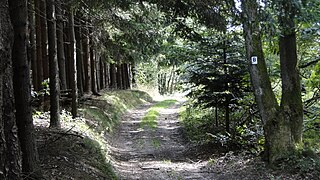
The Birkenhainer Straße is a long-distance hiking trail that follows an ancient trade route through the Mittelgebirge Spessart, in the states of Hesse and Bavaria, Germany. It is 71 km long and leads from Hanau to Gemünden am Main, cutting across the so-called Mainviereck, a large loop of the river Main. The trail follows an ancient trade route which in the Middle Ages was an important road for moving troops and for long-distance trade. The Birkenhainer Straße was a part of the link between Nuremberg and Antwerp. Its origins may lie back as far as the Neolithic period. The name likely derives from a prominent copse of birch trees that used to exist near the road at Geiselbach (Hesse).

The Mittelweg is a north-south long-distance path which runs through the Black Forest from Pforzheim to Waldshut. It is about 230 kilometres long and was established in 1903. Since then it has been maintained and sponsored by the Black Forest Club. Its waymark is a red diamond with a white bar on a white background.

The Gengenbach–Alpirsbach Black Forest Trail is a long distance path through the Central Black Forest in Germany. The 51-kilometre-long east-west route is sponsored and maintained by the Black Forest Club. Its waymark is a blue diamond on a yellow background.
The Black Forest North Perimeter Way is a 55-kilometre-long hiking trail in three stages running from Mühlacker to Karlsruhe-Durlach in Germany.

The Kaiserstuhl–Rhine Black Forest Trail is an east-west hiking trail of several days duration through the Black Forest in Germany from Donaueschingen to Breisach. The 109-kilometre-long hiking trail is managed and maintained by the Black Forest Club.
The Gäu Perimeter Way is a hiking trail in the Northern Black Forest in Germany and the easternmost of the long distance paths managed by the Black Forest Club. With a length of 120 kilometres, it runs in six stages from Mühlacker to Freudenstadt.


